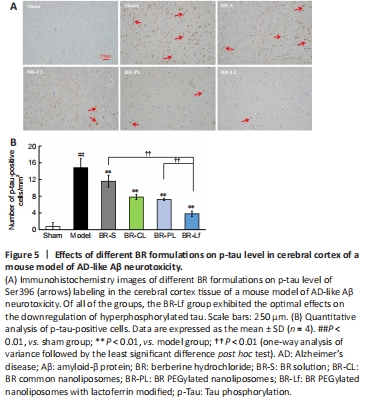神经退行性病
-
Figure 1|Transmission electron microscope images of different BR nanoliposomes.

The BR-CL, BR-PL, and BR-Lf nanoliposomes particle sizes were similar and narrowly distributed. The entrapment efficiency of BR nanoliposomes was more than 90%. The grafting ratio of Lf in BR-Lf was 65.9 ± 2.2% as shown in Table 3. Lf modification did not have much impact on particle size or entrapment efficiency of BR nanoliposomes. Microstructural observation showed that BR-CL, BR-PL, and BR-Lf were all quasi-circular unilamellar nanoliposomes with evident bilayer membranes (Figure 1). They were evenly distributed and their sizes were consistent with the particle size analysis.
Figure 5|Effects of different BR formulations on p-tau level in cerebral cortex of a mouse model of AD-like Aβ neurotoxicity.

Immunohistochemistry results showed that the number of p-tau-positive cells in the cerebral cortex was higher in the model group than in the sham group (P < 0.01). The numbers of p-tau-positive cells in the BR-S group and BR nanoliposomes groups were decreased to different degrees compared with that in the model group (all P < 0.01). The number of p-tau-positive cells in the BR-Lf group was lower than that in the BR-PL group (P < 0.01) and that in the BR-S group (P < 0.01; Figure 5).
点击此处查看全文